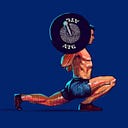The ATG Approach to Feet
I’m often asked about the ATG approach to feet.
My mind jumps to 3 basics and 2 bonuses:
Basics
- Backward
- Calf
- Tib
Bonuses
- Shoe with wide toe box
- Big toe spacer
Let’s break this down…
PRINCIPLE 1: We’re operating on the theory that if enough ABILITY is present relative to the demand, the body will NOT break down.
When you step backward you’re fundamentally training the ABILITY of the foot because you’re pushing through your toes on every step.
Whether this is done by walking backward, sledding backward, or treadmilling backward (with sled turned off, or human-powered treadmill), it seems to get the job done in terms of foot warm-up.
I had chronic foot pain that went away with no changes in my lifestyle other than stepping backward becoming a go-to exercise in my routine.
And now from 13 years of coaching experience, I’ve seen top results from using straight-leg AND bent-knee calf raises.
In Knee Ability Zero this is represented by FHL and KOT Calf Raises.
In weighted ATG programs, this is represented by single-leg standing and single-leg seated calf raises.
PRINCIPLE 2: You can’t be too strong from the ground up.
Your upper body COULD be too heavy for your lower body.
Your back COULD be too strong for your legs.
Your legs COULD be too strong for your feet and ankles.
But your feet and ankles CAN’T be too strong for what’s above!
Stepping backward, straight-leg calf raises and bent-knee calf raises are a well-rounded approach for this.
But there MAY be a missing link for some people…
PRINCIPLE 3: Deviation from the body’s natural design leads to more problems; restoring the body’s natural design results in fewer problems.
A common deviation in modern society is that the big toe has been jammed inward by dress shoes and sports shoes which point inward for style, even though the foot isn’t naturally shaped like that. Millions of people now have deformed big toes that go inward. This would result in the muscles of the foot not functioning as intended, AND THERE ARE 29 MUSCLES ASSOCIATED WITH THE FOOT.
But here’s some good news for you…
I am an example of someone who ended up with deformed feet due to decades in modern sports shoes.
Simply by addressing the BASICS, I’m totally symptom-free in my feet and lower legs.
HOWEVER, I have spent the past few years in shoes that at least ALLOW my big toe to have space, and this may have assisted my progress.
I even went so far as to make the first barefoot-inspired sneaker with two of my closest friends. We only have a few sizes available but thanks to your feedback, we’re rapidly dialing in a Model 2. Model 1 is ideal for exercise and Model 2 will be ideal for competition.
Most barefoot shoes have as little support as possible, since it’s not natural for the foot to have support. HOWEVER, it’s also not natural to be walking on concrete all day, so I believe a common-sense solution is to have SOME support, but no jammed-in big toe, and no excessively big heel cushion, both of which were developed for STYLE, with ZERO attention on health.
If your big toe is extremely jammed in, you may even consider a spacer to straighten it out while you perform the above exercises. You’ll feel your foot muscles engaging more.
Until a few years ago, this would have seemed like a full approach, but it’s not…
PRINCIPLE 4: A body is only as bulletproof as it is strengthened against the outside world and BALANCED within ITSELF.
Even after stepping backward AND calf training became part of my routine, I still had nasty shin pain when I tried to jump with maximum intent.
The last 5 years have seen a worldwide shift in awareness and application of training the ANTERIOR TIBIALIS, thanks to ATG and YOU spreading the knowledge.
This muscle is not only the primary decelerator of your foot — meaning it controls how much force slams into your foot to begin with — it also attaches all the way down to the inside of your foot! I assumed it was only up on the shin by the knee, but it actually takes a turn across the lower leg and goes quite far down.
With Zero, free weights, and even full machines on the horizon, we have tibialis training mastered for broad use.
Now you have some go-to moves for foot and lower ABILITY, plus some common-sense additions you may enjoy exploring.
To be clear, this is not a program on the app, since these are already part of existing ATG programs.
I spent the majority of this week writing about 11 steps for Back Ability Zero, which you can do at home with ZERO gym equipment. I’ll be back in touch next week with a lengthy article, photos, and new form videos on the app, delivering a separate breakdown of Back Ability Zero vs. Back Ability Pro.
Thank you so much for your support of ATG.
Yours in Solutions,
Ben
